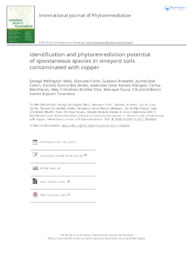Identification and phytoremediation potential of spontaneous species in vineyard soils contaminated with copper.
Identification and phytoremediation potential of spontaneous species in vineyard soils contaminated with copper.
Autoria: MELO, G. W. B. de; FURINI, G.; BRUNETTO, G>; COMIN, J. J.; SIMÃO, D. G.; MARQUES, A. C. R.; MARCHEZAN, C.; SILVA, I. C. B.; SOUZA, M.; SOARES, C. R.; ZALAMENA, J.
Resumo: Copper (Cu) contents in vineyard soils due to the application of cupric fungicides cause changes in the native covering flora. Under these conditions, the surviving individuals accumulate the metal in and decrease its availability in the soil, reducing the potential toxicity to grapevine. We have identified spontaneous plant species and their phytoremediation potential from vineyards of Isabella (Vitis labrusca) on two distinct soil types (Inceptisol and Entisol) contaminated with Cu. The results demonstrated that wild species displayed higher Cu contents in the roots than in the shoot, but had low bioaccumulation potential. During summer, the plants were unable to extract and stabilize the metal, although during the winter, Lolium multiflorum, Cyperus compressus and Chrysanthemum leucanthemum demonstrated phytostabilization potential. Among the investigated species, dry matter production and Cu accumulation by Lolium multiflorum indicated that the species is effective to decrease Cu availability in the soil.
Ano de publicação: 2021
Tipo de publicação: Artigo de periódico
Unidade: Embrapa Uva e Vinho
Palavras-chave: Copper, Cover crop, Heavy metal, Mitigation, Vitis sp
Observações
1 - Por padrão são exibidas publicações dos últimos 20 anos. Para encontrar publicações mais antigas, configure o filtro ano de publicação, colocando o ano a partir do qual você deseja encontrar publicações. O filtro está na coluna da esquerda na busca acima.
2 - Para ler algumas publicações da Embrapa (apenas as que estão em formato ePub), é necessário ter, no celular ou computador, um desses softwares gratuitos. Sistemas Android: Google Play Livros; IOS: iBooks; Windows e Linux: software Calibre.
Acesse outras publicações
Acesse a Base de Dados da Pesquisa Agropecuária (BDPA) para consultar o acervo completo das bibliotecas da Embrapa.

